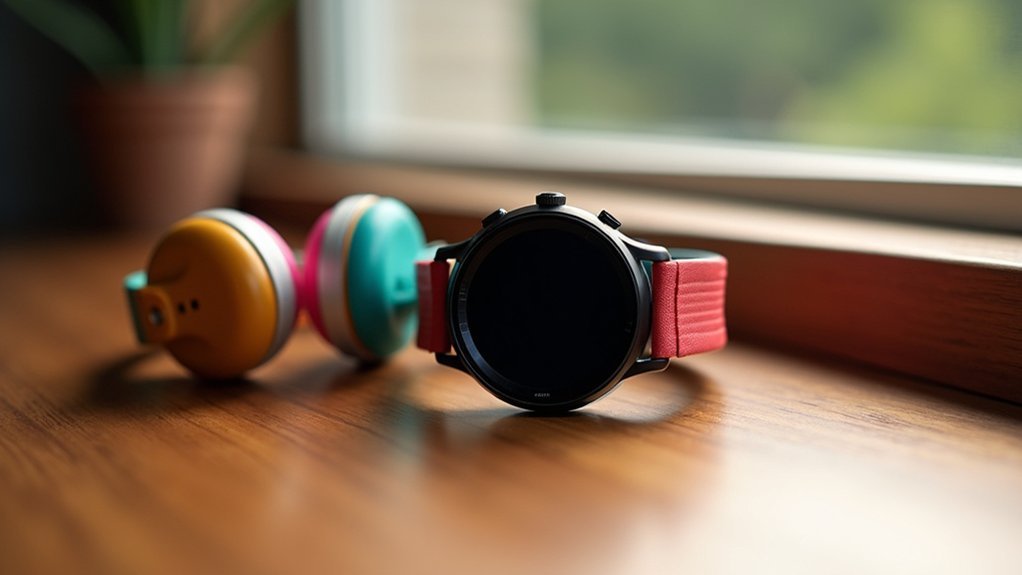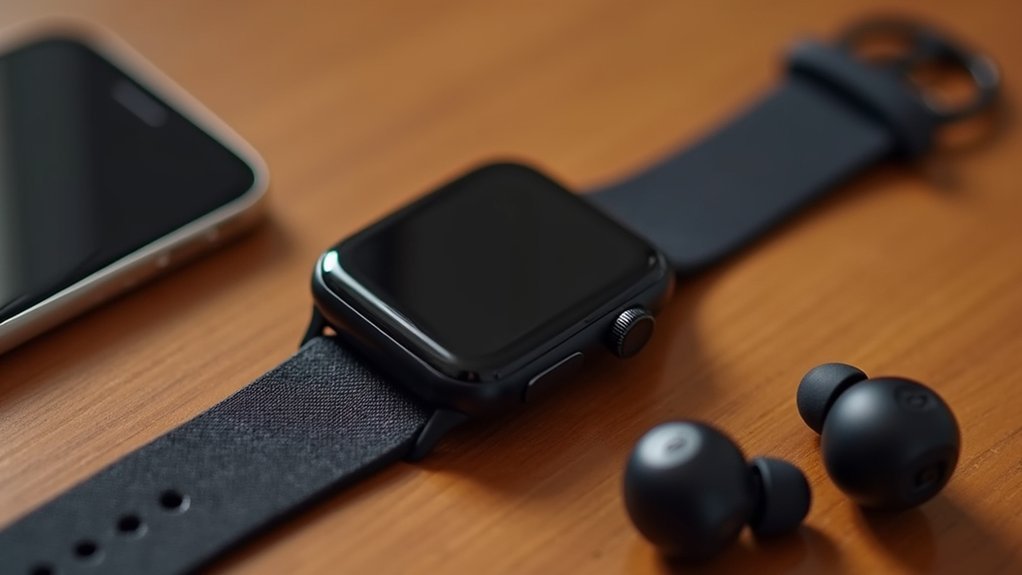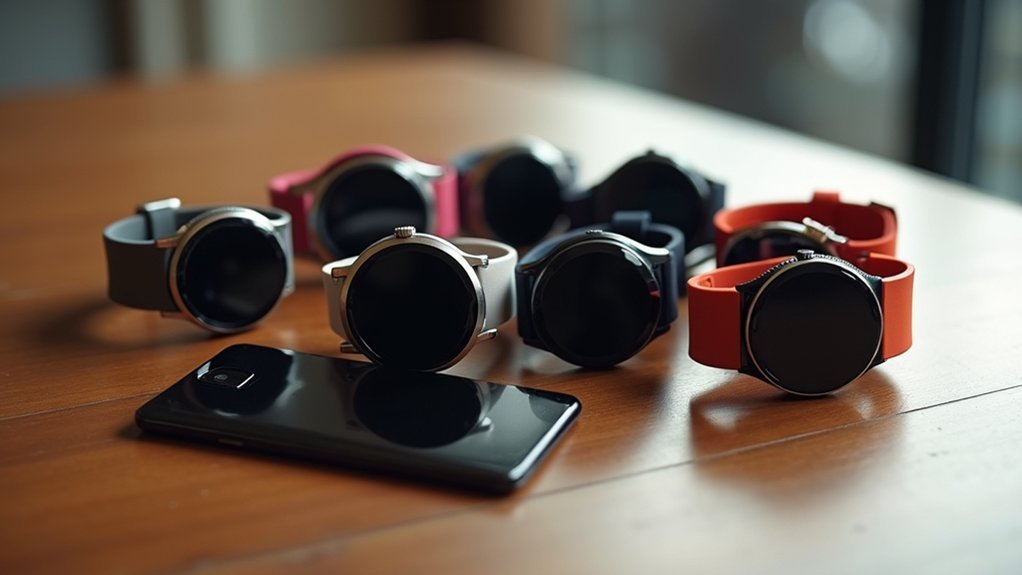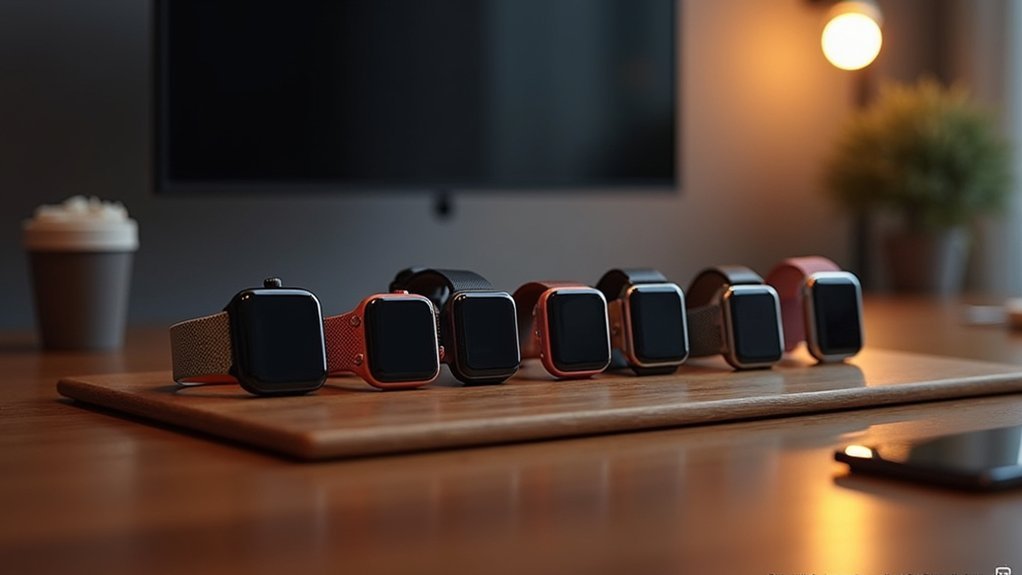You can enjoy phone-free music with three excellent smartwatch options. The Garmin Venu 2 offers premium offline storage with 7GB space and supports downloads from streaming services, though it requires Bluetooth headphones. For budget-conscious users, the Syska SW300 POLAR stores 100 songs at Rs. 2,799 with 10-day battery life. The Amazfit Cheetah provides standalone music playback with sleek design. Each watch supports iOS and Android connectivity, ensuring you’ll discover the perfect features for your specific needs.
Garmin Venu 2: Premium Offline Music Storage and Multi-Day Battery Performance

When you’re ready to ditch your phone during workouts, the Garmin Venu 2 delivers premium offline music storage with approximately 7 GB of usable space for your favorite tracks. You can download music directly from streaming services, transfer personal audio files via USB, or sync playlists through Wi-Fi connectivity.
The watch supports Bluetooth headphones for playback since there’s no built-in speaker.
Audio playback requires pairing with Bluetooth headphones as the device lacks an integrated speaker system.
You’ll enjoy multi-day battery performance under regular smartwatch usage, though continuous music playback will reduce longevity. The bright AMOLED display automatically adjusts brightness to preserve power during music sessions.
Offline music licenses require internet renewal every 7 days, but once synced, you’re free to exercise without carrying your smartphone while controlling playback through the intuitive touchscreen and button interface. The watch supports various audio formats for maximum compatibility with your existing music library.
Budget-Friendly Options: Syska SW300 POLAR and Amazfit Cheetah for Standalone Music Playback
Two standout budget-friendly options deliver standalone music playbook without breaking the bank: the Syska SW300 POLAR and Amazfit Cheetah.
You’ll get impressive value with the Syska SW300 POLAR, priced at Rs. 2,799, featuring built-in storage for 100 songs and direct TWS earphone connectivity. Its 1.32-inch display, 10-day battery life, and IP67 water resistance make it surprisingly capable for the price.
The Amazfit Cheetah offers another compelling choice, though specific storage details aren’t readily available.
Both watches support iOS and Android connectivity, ensuring you’re not locked into one ecosystem. The SW300 POLAR includes 37 sports modes for comprehensive fitness tracking during your workouts. You’ll appreciate the Syska’s Bluetooth calling feature and crown navigation, while Amazfit’s reputation for sleek design and comfort makes it worth considering for your phone-free music needs.
Essential Features to Consider: Storage Capacity, Streaming App Compatibility, and Bluetooth Connectivity

Before committing to any smartwatch for phone-free music, you’ll need to evaluate three critical features that’ll make or break your listening experience.
Storage capacity determines how many songs you can carry offline. Budget models like Garmin 4Runner 165 offer 4GB for roughly 500 songs, while premium options like Garmin 4Runner 965 provide 32GB for around 2,000 tracks.
Surprisingly, value-oriented devices like Huawei Watch Fit 2 can store up to 5,000 songs.
Streaming app compatibility matters if you use services like Spotify or Apple Music. Check whether your preferred platform supports offline downloads on your chosen watch model. Some devices like the Samsung Galaxy Watch 7 feature built-in speakers that allow direct music playback without requiring Bluetooth headphones.
Bluetooth connectivity enables wireless audio output to headphones or speakers. Look for Bluetooth 5.0 or higher for better range, improved battery efficiency, and lower latency during movement-intensive activities.
Frequently Asked Questions
Can I Transfer My Own MP3 Files to a Smartwatch?
You can transfer your own MP3 files to compatible smartwatches like Samsung Galaxy Watch using Galaxy Wearable app, Bluetooth transfer, USB connection, or third-party apps, depending on your device’s capabilities.
Do I Need Premium Streaming Subscriptions for Offline Music Features?
You’ll need premium subscriptions like Spotify Premium or YouTube Music Premium for offline downloads on most smartwatches. However, you can transfer your own MP3 files without subscriptions.
How Much Internal Storage Is Typically Needed for Music?
You’ll need 4-8 GB for basic music storage, allowing several high-quality playlists. If you want extensive collections or audiobooks, consider 16 GB for greater flexibility and varied content options.
Will Using Speakers Instead of Bluetooth Headphones Drain Battery Faster?
You’ll find speakers don’t necessarily drain battery faster than Bluetooth headphones. At moderate volumes, speakers may use less power, but high volume levels consume considerably more energy than Bluetooth transmission.
Can Smartwatches Play Music While Swimming or in Water?
You can play music while swimming if your smartwatch has 5 ATM water resistance and offline storage. However, you’ll need waterproof earbuds since Bluetooth doesn’t work underwater effectively.
In Summary
You’ll find these three smartwatches deliver excellent phone-free music experiences. If you’re seeking premium features and extended battery life, you can’t go wrong with the Garmin Venu 2. However, if you’re budget-conscious, the Syska SW300 POLAR and Amazfit Cheetah won’t disappoint. Remember to prioritize storage capacity, streaming app compatibility, and reliable Bluetooth connectivity when making your final decision. You’ll enjoy seamless music playback during workouts, runs, or any activity without your phone.





Leave a Reply